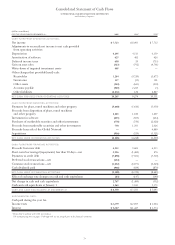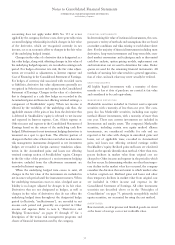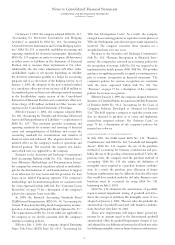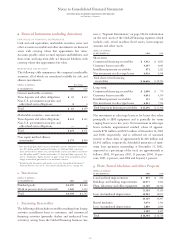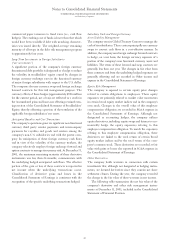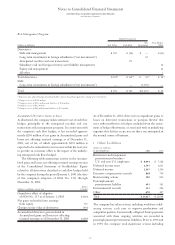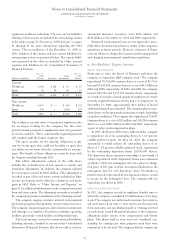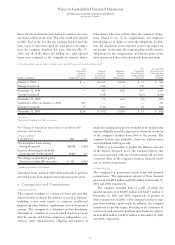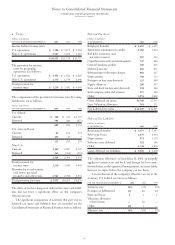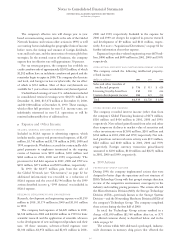IBM 2001 Annual Report Download - page 83
Download and view the complete annual report
Please find page 83 of the 2001 IBM annual report below. You can navigate through the pages in the report by either clicking on the pages listed below, or by using the keyword search tool below to find specific information within the annual report.
Notes to Consolidated Financial Statements
INTERNATIONAL BUSINESS MACHINES CORPORATION
and Subsidiary Companies
81
An initial impairment test must be performed in 2002 as of
January 1, 2002. The company completed this initial transi-
tion impairment test and determined that its goodwill is
not impaired.
In August 2001, the FASB issued SFAS No. 143,
“Accounting for Asset Retirement Obligations.” SFAS No.
143 provides accounting and reporting guidance for legal
obligations associated with the retirement of long-lived
assets that result from the acquisition, construction or nor-
mal operation of a long-lived asset. The standard is effective
January 1, 2003. The company is reviewing the provisions of
this standard. Its adoption is not expected to have a material
effect on the financial statements.
In October 2001, the FASB issued SFAS No. 144,
“Accounting for the Impairment or Disposal of Long-Lived
Assets.” SFAS No. 144 addresses significant issues relating to
the implementation of SFAS No. 121, “Accounting for the
Impairment of Long-Lived Assets and for Long-Lived Assets
to Be Disposed Of,” and develops a single accounting model,
based on the framework established in SFAS No. 121 for
long-lived assets to be disposed of by sale, whether such assets
are or are not deemed to be a business. SFAS No. 144 also
modifies the accounting and disclosure rules for discontinued
operations. The standard was adopted on January 1, 2002,
and is not expected to have a material effect on the financial
statements except that any future discontinued operations
may be presented in the financial statements differently
under the new rules as compared to the old rules.
In November 2001, the FASB issued EITF Issue No. 01-14,
“Income Statement Characterization of Reimbursements
Received for ‘Out of Pocket’ Expenses Incurred.” This guid-
ance requires companies to recognize the recovery of
reimbursable expenses such as travel costs on services con-
tracts as revenue. These costs are not to be netted as a
reduction of cost. This guidance was effective January 1,
2002. The company does not expect this guidance to have a
material effect on the financial statements due to the com-
pany’s billing practices. For instance, outside the U.S., almost
all of the company’s contracts involve fixed billings that are
designed to recover all costs, including out-of-pocket costs.
Therefore, the “reimbursement” of these costs are already
recorded in revenue.
cAcquisitions/Divestitures
ACQUISITIONS
2001
In 2001, the company completed two acquisitions at a cost of
approximately $1,082 million.
The larger was the acquisition of Informix Corporation’s
database software business. In July, the company agreed to
pay $1 billion in cash for the net assets of the business.
Under the terms of the purchase, the company has paid $889
million of the purchase price and will pay the remaining
amount in 2002. The Informix acquisition provides the com-
pany with a database software system for data warehousing,
business intelligence and transaction-handling systems that
are used by more than 100,000 customers. In addition, the
acquisition significantly increased the size of the company’s
UNIX database business. The transaction was completed in
the third quarter of 2001 from which time the results of this
acquisition were included in the company’s consolidated
financial statements.
The allocation of the purchase price for the 2001 acqui-
sitions is presented in the following table in the required
SFAS No. 141 format.
Amortization
(dollars in millions) Life (in years) Informix*Other
Current assets $««««156 $«««57
Fixed/long-term assets 41 21
Intangible assets:
Customer lists 5220 «—
Completed technology 3140 «—
Trademarks 210«—
Goodwill «591 «««25
Total assets acquired $«1,158 $«103
Deferred revenue (101) «(2)
Payables/accrued expenses (55) (21)
Total liabilities assumed $«««(156) $««(23)
Net assets acquired $«1,002 $«««80
*During the fourth quarter, the company revised the estimates originally disclosed
in the third quarter. These adjustments resulted in an additional $40 million of
goodwill and a corresponding decrease in tangible net assets acquired. There was
no adjustment in the purchase price or in the company’s earnings.
The overall weighted-average life of intangible assets pur-
chased from Informix is 4.2 years. Goodwill of $591 million
has been assigned to the Software segment. Almost all of the
goodwill is deductible for tax purposes. The primary items that
generated this goodwill are the value of the acquired assembled
workforce and the synergies between the acquired business and
IBM. This transaction occurred after June 30, 2001, and there-
fore, the acquired goodwill is not subject to amortization.
2000
In 2000, the company completed nine acquisitions at a cost
of approximately $511 million.
The largest acquisition was LGS Group Inc. (LGS). The
company acquired all the outstanding stock of LGS in April
for $190 million. LGS offers services ranging from application
development to information technology (I/T) consulting.





